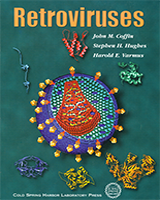NCBI Bookshelf. A service of the National Library of Medicine, National Institutes of Health.
Coffin JM, Hughes SH, Varmus HE, editors. Retroviruses. Cold Spring Harbor (NY): Cold Spring Harbor Laboratory Press; 1997.
Retroviruses are associated with a wide variety of diseases including an array of malignancies, immunodeficiencies, and neurologic disorders. Syndromes as seemingly diverse as arthritis, osteopetrosis, and anemia can all result from retroviral infection. These disorders afflict a large number of different creatures, ranging from clams and fish to birds and mammals, including humans. Some of these disorders have significant agricultural impact, crippling farm animals during their most productive years, whereas others have a devastating medical and economic impact on humans. Still others, particularly many of the retrovirus-induced malignancies of rodents, were found originally in laboratory settings and provide excellent model systems for probing the biological and molecular mechanisms of carcinogenesis.
Study of these disorders has provided critical information about the ways in which retroviruses induce disease. In addition, the mechanisms involved in these diseases have shed important light on the way in which similar conditions, lacking a retroviral etiology, arise. As noted in Chapter 1 studies of tumor induction by retroviruses provide the basis of much of modern molecular tumor biology. The discovery of viral oncogenes and the ways in which such genes can induce tumors provided both the intellectual framework and the molecular tools that have led to a deeper understanding of the mechanisms important for the development of all cancers. These investigations also helped lay the foundation for our current understanding of signal transduction and normal cellular growth control.
The power and elegance of retroviral models of malignant disease extend far beyond historical significance. Contemporary investigations of retrovirus-induced malignancies continue to further our understanding of these complex disorders. The ease with which retroviruses can be manipulated and the relatively simple well-characterized in vitro and in vivo models facilitate studies addressing the genetic basis of tumor development. The parts played by individual viral genes as well as the genetic background of the host can be investigated. Many of these systems use inbred mice, making it possible to identify host genes that modify the outcome of infection. Although some of these genes affect aspects of pathogenesis that are unique to particular viruses, others have broad ranging effects that are relevant to other disease models. The ability to control delivery of oncogenes to particular cells allows dissection of the consequences of oncogene expression on both growth and differentiation. In addition, studies of tumors induced by retroviruses that lack oncogenes continue to reveal genes that mediate novel and important aspects of cellular growth.
Studies probing the pathogenic mechanisms used by retroviruses that induce nonmalignant diseases have made major contributions to our understanding of persistent infections. Although many of the retroviral tumor models involve laboratory-based experimentation, infections with these retroviruses occur naturally and are widespread in several different types of animals. Infection of farm animals with a variety of lentiviruses can lead to debilitating diseases that have a serious economic impact on the agricultural industry. Analyses of these disorders provide an important avenue to address the mechanisms involved in virus variation and the role that variation has in disease progression. In addition, mechanisms by which the host attempts to control persistent infection at different stages of the disease can be addressed using these models. The emergence of acquired immunodeficiency syndrome (AIDS) has made these issues particularly urgent (see Chapter 11. Even though many animal lentiviral infections clearly involve pathogenic mechanisms that do not have a major role in AIDS, these models are still extremely useful and their study may yield information which will suggest strategies by which human immunodeficiency virus (HIV) infection can be controlled or which will allow moderation of AIDS. Retrovirus-induced diseases of the central nervous system (CNS) provide important models to examine the mechanisms by which infection can induce loss of neuronal cells. Some of these mechanisms may be similar to those that mediate neuronal damage in CNS infections that lack a retroviral etiology.
- Review Oncogenesis by retroviruses: old and new paradigms.[Rev Med Virol. 2008]Review Oncogenesis by retroviruses: old and new paradigms.Maeda N, Fan H, Yoshikai Y. Rev Med Virol. 2008 Nov-Dec; 18(6):387-405.
- Review Retroviral Virions and Genomes.[Retroviruses. 1997]Review Retroviral Virions and Genomes.Vogt VM. Retroviruses. 1997
- Review Engineering Aspects of Olfaction.[Neuromorphic Olfaction. 2013]Review Engineering Aspects of Olfaction.Persaud KC. Neuromorphic Olfaction. 2013
- Review Reverse Transcriptase and the Generation of Retroviral DNA.[Retroviruses. 1997]Review Reverse Transcriptase and the Generation of Retroviral DNA.Telesnitsky A, Goff SP. Retroviruses. 1997
- Current thoughts on the viral etiology of certain human cancers: The Richard and Hinda Rosenthal Foundation Award lecture.[Cancer Res. 1984]Current thoughts on the viral etiology of certain human cancers: The Richard and Hinda Rosenthal Foundation Award lecture.Gallo RC, Wong-Staal F. Cancer Res. 1984 Jul; 44(7):2743-9.
- Retroviral Pathogenesis - RetrovirusesRetroviral Pathogenesis - Retroviruses
- Profile neighbors for GEO Profiles (Select 130289934) (199)GEO Profiles
- One Health Enteric sample from Klebsiella variicolaOne Health Enteric sample from Klebsiella variicolabiosample
- BioSample links for Nucleotide (Select 2642880298) (1)BioSample
- Taxonomy Links for Nucleotide (Select 2427302005) (1)Taxonomy
Your browsing activity is empty.
Activity recording is turned off.
See more...
